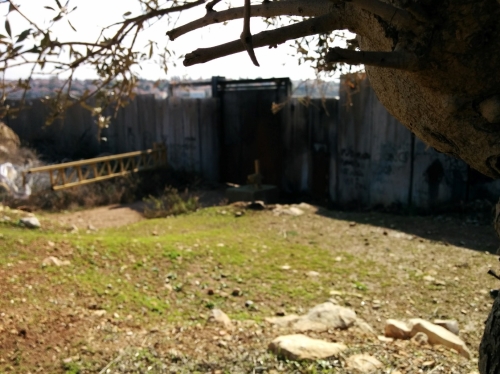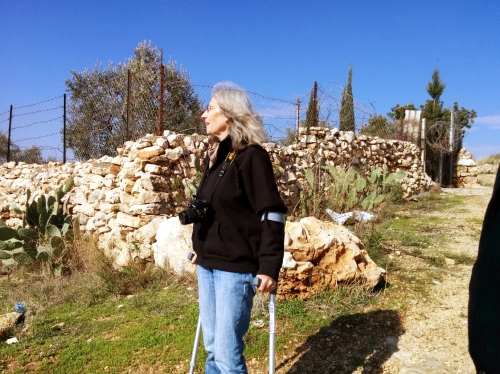Ni'lin (Qiryat Sefer)
The separation wall, built in 2004-2008, slices through the olive groves belonging to Ni’ilin’s 5000 residents, leaving 3290 dunums of olives cut off from the village by the wall, and a terrifying gate that opens once in a…
Of the 54,000 dunums that before 1948 belonged to the village, whose livelihood is based on agriculture, only 8911 remain. 40,000 dunums are beyond the Green Line and the remainder was stolen after the occupation of the West Bank in 1967, for the construction of the illegal settlement of Modi’in Illit and its infrastructure, Matityahu and Hashmona’im, and for building the wall.
The weekly demonstrations against the wall continue in the groves between the village and the wall. In the adjacent villages of Budrus and Bil’in demonstrations ended after the Supreme Court ordered a small change in the wall’s path. From the Budrus cemetery the change is noticeable (cf. photo). Our Guide to the Perplexed of the separation fence’s evils here was M., the leader of the Ni’ilin demonstrations and the science teacher in the local high school. That role exposes him to political harassment worthy of the most oppressive regimes, even though it’s a non-violent struggle by defenseless protesters. He’s forbidden to access his groves beyond the wall: “Even if they grant a permit to cross it won’t be for the days when I'm not teaching.” Last year his wife picked a full sack of olives and bore it on her back. Her shoulder still hurts. So this year the olives remained on the trees. The area between the wall and the fence of the adjoining settlement has been denoted a firing range, as has, on Fridays, the area between the village and the wall.
We reached the wall through the groves littered with an unimaginable number of spent tear gas grenades and cartridges of what are supposedly rubber bullets. Many of the olive trees are charred and those near the wall are even burned. M. knows every tree. The five girls accompanying the old shepherd scattered as we approached. Why? I asked M. “When they see me,” he replied, “they expect tear gas grenades to be fired at them.” He shows me the position sticking up beyond the wall. I hadn’t noticed it. “I see only beautiful things,” I said in excuse. “Great,” he said with a serious smile. After all, he’s a science teacher.
At the mouth of a well, carved into the rock a few meters from the wall, he shows us depressions in the stone filled with water for birds. “That’s why life used to be better – it also considered the birds,” he said.
I quote from Ilan Shelif’s weekly email inviting people to join the Friday demonstrations: “Since 2008 Ni’ilin’s non-violent demonstration against Israel’s separation wall has been met with violent repression. Dozens of demonstrators have been arrested – including the leaders of the villagers’ own struggle – and jailed for many months. Four demonstrators have been murdered by live ammunition: A’aqel Srur (36), Arafat Khawwaja (22), Muhammad Khawwaja (20) and Ahmad Musa, a ten year old boy. An additional demonstrator, Yusuf Amira (17), was shot and murdered by rubber bullets. An American solidarity activists, Tristan Anderson, was seriously wounded by a tear gas grenade fired right at him. Contact Kobi, 054-219-1547!! It’s important!!”
Ni’ilin is one of 24 “crown villages” among which the West Bank was divided in Ottoman times. Each village was ruled by a family which possessed a palace or a castle or a fortress, most of which have been restored by Riwaq, an organization of Palestinian architects and artists headquartered in Bir Zeit. Riwaq does wonderful work restoring historic buildings for the benefit of local communities (We highly recommend visiting their website to see the Womens Center in Sebastiya https://kayedpalace.wordpress.com/history/ ). The restoration of the palace in Ni’ilin was completed as the wall was being built in 2008.
In Ni’ilin we focused on the wall and left without seeing the renovated fortress, but we didn’t miss it in the adjacent village of Ras Karkar, which sits on a hilltop.

Thinking about “Judgement Day” and “exchange of territory,” I think it’s appropriate to learn about and concentrate on the centers of the old villages, some of which are being restored while many others are abandoned (also because residents have left). Because they’re irreplaceable. They represent history, and are the pride of the villagers.




 |
